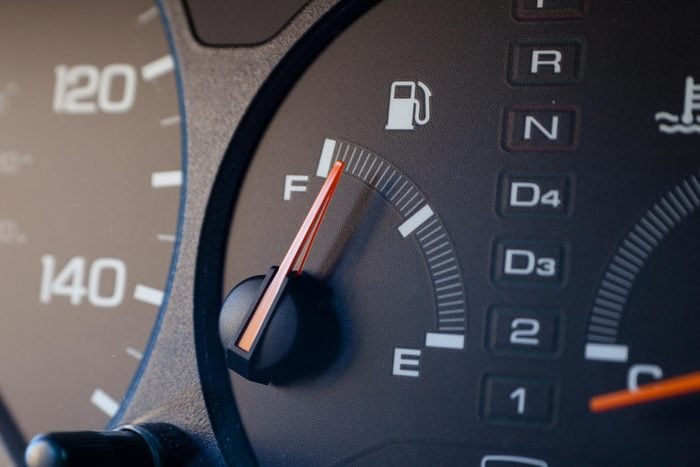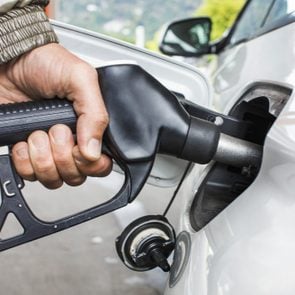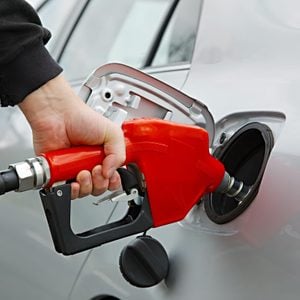How to Get Better Gas Mileage: 9 Simple Ways to Save
Updated: Feb. 01, 2024

How far would you go to save a buck on a gallon of gas? No need to do anything drastic—just follow these tricks to learn how to get better gas mileage.
Finding cheap gas these days feels like winning the lottery. With fuel prices at record highs, you need to squeeze the most out of every precious drop. By learning how to get better gas mileage, you’ll end up with more green in your wallet—and help the environment. Fortunately, you don’t have to go to great lengths to get your car to travel more miles before hitting “E” on the fuel gauge.
These tips from auto experts will teach you how to save money on gas so you can hang on to more than $1.50 per gallon at the pump and improve gas mileage by at least one-third. Once you’ve learned how to get better gas mileage, take your frugality up a notch by using gas credit cards and gas apps when filling up. Ready, set … save!
Test your tire pressure
The number one thing you can do to improve gas mileage: Keep your tires inflated at the level recommended in your car’s owner’s manual. “Just that single step can improve your fuel efficiency 10 to 15 percent,” says Andrew Gross, a spokesperson for the American Automobile Association (AAA). “If you can’t remember the last time you checked the pressure, the tires are low.”
Flatter tires, he explains, make your car’s engine work harder, increasing the amount of fuel used. Overinflated tires may be troublesome as well. “They can cause uneven or premature tire wear, which may affect fuel economy,” says Todd Hill, product public relations manager for Subaru of America. Hint that your tires are over- or underinflated: They squeak while driving.
Many gas stations offer free use of a tire-pressure gauge, but you can also pick up a device to use at home for under $10.
Consider fuel-efficient tires
Want to know how to get better gas mileage? Buy better tires. They’re the one part of your car that touches the road, so they play a major role in fuel efficiency.
If you need to replace your tires anyway—most last 60,000 to 75,000 miles—look for a fuel-efficient model, suggests Greg Harrington, service manager of Independent Motors in Boulder, Colorado. “As you drive, fuel-efficient tires maintain less contact with the road’s surface,” he says. “They’re also reinforced with certain compounds designed to give you better fuel economy.”
Firestone Champion Fuel Fighter and Bridgestone Ecopia are two fuel-efficient tire models car experts recommend. Ecopia tires have been shown to get an extra 20 miles per tank.
Store stuff in the trunk—not on the roof
Hauling cargo on your roof seems smart and cool, but it’s a major gas-sucker compared to storing your junk in the trunk. Those rooftop cargo boxes affect your car’s wind resistance, so you need to use more fuel to maintain your speed—and not just a little more.
A rooftop cargo box can reduce fuel economy by up to 25 percent when you’re driving on the interstate at 65 to 75 miles per hour. Even if you score a good deal on gas (thanks, cheap Costco fuel!), your wallet will feel the effect of hauling heavy cargo on your roof.
“People in Colorado ride around all the time with rooftop tents, and they’re killing their gas mileage,” says Harrington. While having stuff in your trunk does decrease your fuel economy by about 1 percent per 100 pounds, it’s a more economical place for storage than the roof.
Drive the speed limit
Look to your speedometer for how to get better gas mileage. When you’re going more than 50 miles per hour, your gas mileage decreases rapidly. For every five miles per hour you drive over 50, it’s like paying 30 cents extra for a gallon of gas, according to the U.S. Department of Energy.
Getting better gas mileage simply involves slowing down. Of course, you need to keep up with the flow of traffic. But if you’re on a 55-mile-per-hour road, set the cruise control for that speed rather than 65 miles per hour, and you’ll save yourself 60 cents per gallon of gas. Bonus: You’ll avoid a speeding ticket too.
Keep tabs on traffic
Idling in bumper-to-bumper traffic wastes a quarter to a half gallon of gas per hour, depending on your engine size and whether you’re running the AC. Check a traffic app like Google Maps before you head out.
Of course, some traffic jams are totally unavoidable. Turn off your engine if you’re not moving at all; the U.S. Department of Energy has calculated that it takes only 10 seconds’ worth of fuel to restart your car.
Do those two things, and you can avoid hitting the gas station quite so often. Speaking of stopping at the pump, do you know how gas pumps know when your tank is full?
Be a chill driver
Speeding and slamming on the brakes—hallmarks of aggressive driving—waste gas big time. Researchers at the government’s Oak Ridge National Laboratory found that aggressive driving reduces gas mileage in stop-and-go traffic by up to 40 percent.
Keep up with regular maintenance
Basic car maintenance—replacing air filters, spark plugs, transmission fluid, and oil as needed—keeps your car’s engine in good shape and maximizes your fuel efficiency, says Harrison. Check the owner’s manual to find out how often you need to have your vehicle serviced.
Plan your errands
On days you have a lot of stops to make, drive to the farthest place first and then work your way back closer to home, suggests Gross. “People waste a lot of gas zigzagging around,” he says.
Another idea for how to save gas: Avoid running errands during peak traffic times to reduce your chance of getting stuck in a jam.
Rethink your next car
The next time you need to buy or lease a new car, look no further than hybrid and electric models for how to get better gas mileage. They’re getting better every year. “I switched from a Toyota Tundra to a Toyota Prius,” says Harrington. “I used to spend $240 per month on fuel, and that’s when prices were much lower, and now I spend $60.” Investing in eco-friendly cars is another option to consider if you’re looking to keep the gas expenses in check.
You may also be eligible to receive a federal tax credit of up to $7,500 when you purchase certain electric and plug-in hybrid vehicles. Check out FuelEconomy.gov for the full list of qualifying models.
Sources:
- Andrew Gross, spokesperson for the American Automobile Association
- Todd Hill, product public relations manager of Subaru of America
- Greg Harrington, service manager of Independent Motors in Boulder, Colorado
- U.S. Department of Energy: “Driving More Efficiently”
- Oak Ridge National Laboratory: “Sensible Driving Saves More Gas Than Drivers Think”
- U.S. Department of Energy: “Federal Tax Credits for All-New Electric and Plug-In Hybrid Vehicles”



